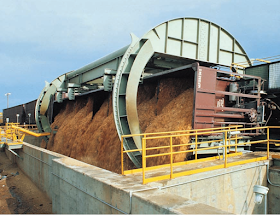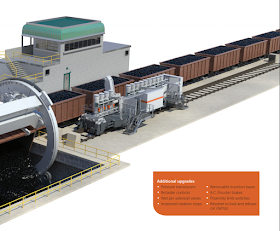 |
| Brochure, p3 |
 |
| 20180908 4927c |
Today I can still find hopper cars in Maintenance-of-Way use. This cut of hoppers was stored in BNSF's Naperville, IL yard when they replaced 18,000 ties in M2 in one weekend with two crews. I think the hoppers is where the GREX Slot Machines dumped there old ties after each nights work.
 |
| 20181025 6530c |
The rivet construction clearly shows where the slanted bottoms are so that the cargo will flow out of the unloading doors.
In addition to reduced capacity, the hopper cars had the problem that frozen chunks of coal could easily block the unloading.
In this overview I took of the yard when I arrived, I have a view of this hopper on an angle. Zooming in (belwo), we can see daylight in the middle of the middle hopper gates. That is because the cars have a center sill down the middle as part of the car's frame.
In the early 1970s, the Clean Air Act required power plants to reduce their sulfur emissions because they were creating sulfuric acid that rained down on states to the east of a power plant. (That act did such a good job of cleaning up the air that some farmers now need to add sulfur to their fields. They are no longer getting it for free from the rain. [DeBruler]) For reasons I have not been able to figure out, power plants in the Southeast, Indiana and Kentucky were able to afford adding scrubbers for sulfur; but power plants in Illinois claimed they could not afford it. They chose to switch to coal from Wyoming instead of the Illinois coal that they had been burning. Since coal was now going to be hauled long distances, the power companies developed the unit train concept. Since they were buying entire trainsets of coal cars, it was worth their while to spend more on the unloading facility so that the freight cars were cheaper and so that they were easier to unload. Specifically, they installed rotary dumpers and bought high-walled gondolas with a rotary coupler.
 |
| Screenshot from Heyl & Patterson Blog |
 |
| 20150427 0486c |
DEEX DETROIT EDISON CO. [pwrr]
MBKX MITSUI RAIL CAPITAL LLC [MITSUI RAIL SERVICES LLC, MRC RAIL SERVICES LLC]
 |
| Railfan Trip |
HEQX *HELM FINANCIAL CORP. (HELM EQUIPMENT LEASING CORPORATION) HEQX *FIRST UNION RAIL HEQX +WELLS FARGO RAIL CORP.
The age of the HEQX bathtub gondola above is between the ages of the DEEX and MBKX cars because it is a bathtub made of steel. See railfanning for more photos that I took of this coal train.
While I was zooming in on a photo, I discovered that I can read the weights. So I got the weights of the three cars discussed so far. I was reminded that the DEEX car is old because the LT WT (empty) weight has faded away. So I found another car where it is readable. The LD LMT on both flat-bottom cars was patched (repainted). One of the issues with aluminum cars is that they can not use flames to heat them when they need to thaw frozen coal. I found the following on the aluminum car: "RADIANT THAW HEAT ONLY MAX ALUMINUM TEMP 250 F."
| Type | LD LMT | LT WT | Sum |
| Flat Bottom | 240,600 | Unreadable | NA |
| Bathtub, Steel | 243,000 | 43,000 | 286,000 |
| Bathtub, Aluminum | 245,200 | 40,800 | 285,200 |
| Flat Bottom | 239,700 | 46,300 | 286,000 |
 |
| 20190630 9430 |
 |
WPSX *W. P. STORK REFRIGERATOR LINE
WPSX *WESTERN PLANT SERVICES (CALIFORNIA)
WPSX +WISCONSIN PUBLIC SERVICE CORP.
|
 |
Street ViewWEPX *WHITE EAGLE OIL & REFINING CO. WEPX +WISCONSIN ELECTRIC POWER CO. |
It is easy to find videos of rotary dumpers in action. In contrast, I have not been able to find a single video of continuous dumping of bottom unload hoppers.
(new window)
(new window) This video taught me about the water spray used to clean off the side rail over which the coal was spilled. The comments indicate that this coal customer is installing the first quad car coal dumper. H&P's web site claims a cycle time as fast as 35 seconds or 5,000 tons per hour. A tandem dumper can do 10,000 tons per hour.
The primary advantage of rotary dumpers is that chunks of frozen coal don't plug the unloading bays of the hopper car. [Heyl & Patterson Blog] In fact, Heyl & Patterson sells a hammermill to help breakup frozen coal chunks that were dumped on the grizzly (unloading hopper grate).
(new window) Just a few seconds of watching it in action shows how the hammermill works.
(new window) (source) This video shows a quad car rotary in action. It looks like they need to add some more water sprinklers to control the dust. At least one dust cloud floated away.
(new window) (source) This plant has to have an incredible conveyor system to handle the tonnage per hour of two quads alternately dumping.
 |
| Screenshot @ 0:54 |
Tyler Riddle posted some photos with the comment: "Wogrubb Crane Rental MLC 300 VPC max picking up a 350,000llb coal car dumper."
Dennis Gaston Did a coal dump last year with MLC300 VPC max in east Tx! With Maxim! Good gig! Be safe!.
 |
| 5 |
 |
| 4 |
 |
| 3 |
 |
| 6 |
Even though the rotary coupler avoids having to uncouple cars to rotate them, you still have the constant stopping and starting of the train. The maximum speed that the train can be moved is determined by the acceptable forces on the coupler knuckles after the slack runs out. [RailKnowledgeBank] The manufactures of rotary couplers take advantage of the stopping-and-starting by selling car positioning units and hydraulically controlled wheel locks. The car positioner can go back for the next car while a car is being dumped. The positioner uses a big arm that it lowers between the cars to push the cars.
 |
| Brochure, p5 |
 |
| Screenshot |
 |
| Brochure, p8 |
The same train that had the block of gondola cars carrying pipe also had a block of modern hopper cars. Because I got caught by this train while in traffic, I'm not talking the normal "railfan" angle of this hopper. Consequently you can see the arms underneath that open and close the gates.
AOKX GREENBRIER MANAGEMENT SERVICES, LLC
Update:
 |
| Michael Matalis posted Where old rotary gons go to die. A long way from the Powder River Basin an old rotary gon now in scrap metal service. 7/9/19 |
 |
Waxhaw Railroads posted Whoops #2- Railroading is full of "Erkel" moments, acts of nature, malfunctions and "I don't know how that happened" events in life! Some take a little time before you can chuckle... This? Oh my goodness. You gotta be kidding! HOW do we get out of this?! You're looking at a beautiful Canadian National RR locomotive #8022, laying on its side 75°, onto a control building, with yellow machines [maintenance of way] standing by to begin their work, AND two guys not about to go in that building! #8022 is an SD70M-2 [Standard Service, 70 series, M for coMfort wide cab, -2 for tier 2 Federal requirements for pollution control]. It is one of 1609 built in 2004 by EMD [Electro Motor Division of GM]. It is rated at 4,300 hp and in this case was pulling a coal train into a coal rotator-dump machine. If you have watched a coal train go through Waxhaw [90-180 coal cars] you may have noticed one end of each coal car is painted red. That indication tells everyone where the rotary coupler is. All of the red ends of the cars should be pointing toward the locomotive. That allows each car to go through the dumper without rolling the entire train over. If only ONE car in the train is facing in the wrong direction in the dumper, guess what happens? The train gets rolled over. So there you have it. One 'outta-place' car = one derailed loco. So, how do you fix this? Not so easily. The beast is 74'2" long, 15'8" tall and 10'3" wide, weighing in at a whopping 218 tons, WITH a 75° list. There is barely enough room to squeeze the yellow lift machines in there. But slowly, carefully, they re-rail the machine. Solution? Always have a double-ended rotator-coupled car behind the locomotive for extra non-rollover action! One thing is certain: that coal freighter did not leave dock that day! ---S. David Carriker Rick Halter shared Brendan J Dock Side booms are not MOW FYI Contractor N.L. Brown Old picture Darrin Otsig Looks like one of the dumpers at Westshore terminals. And that control room is the hydraulic building for the rail clamps. The ‘yellow’ equipment is actually the equipment that indexes the train through the dumper. |
 |
| Stewart Murray commented on Rick's share Not the 1st time CN has done an oil change like that! May 2016. |
A 0:52 video of a dump cycle






Excellent pictures and summary. I stumbled on your page while looking for rotary dump information to bring gypsum from a power plant west via rail.
ReplyDelete